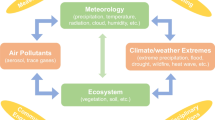Abstract
To investigate effects of atmospheric pollutants on fog nature, a comprehensive in situ observation project was implemented in the northern suburb of Nanjing, in December of 2006. For December 24–27 there occurred a heavy fog lasting 4 d in succession. This event is of rare characteristics, namely long persistence, high concentration, tall fog top, acid fog water and explosive growth. Detailed analysis along with the causes of the fog was presented. The evidence suggests that the fog was generated by nighttime radiative cooling, maintained and developed under effects of warm, wet advection. As a result, it is an advection-radiation fog event.
Similar content being viewed by others
References
Group of Comprehensive Research in Major Natural Disasters of National Commission of China. Measures against Major Natural and Urban Disasters of China (Pandect) (in Chinese). Beijing: Science Press, 1994
Ding Y H, Ren Z H. On Meteorology and Sustainable Development, in Research into the Strategy of Chinese Meteorological Work Development (in Chinese). Beijing: Meteorology Press, 2004
Roach W T, Brown R, Caughey S J, et al. The physics of radiation fog. Part I: A field study. Q J R Meteorol Soc, 1976, 102: 313–333
Pilie R J, Mack E J, Kocmond W C. The life cycle of valley fog. Part I: Micrometeorological characteristics. J Appl Meteorol, 1975, 14: 347–363
Jiusto J E, Lara Grieser J G G. Radiation fog field programs, recent studies. ASRC-SUNY, 1983, Publ No: 869
Fuzzi S, Facchini M C. The Po Valley fog experiment 1989: An overview. Tellus Ser B-Chem Phys Meteorol, 1992, 44: 448–468
Bao B T, Su J X, Zhu B Q. Research on physical and chemical properties of urban fog in Shanghai. J Nanjing Inst Meteorol (in Chinese), 1995, 18(1): 114–118
Li Z H, Zhang L M, Zhang Q H. The physical structure of winter fog in Chongqing metropolitan area and its formation process. Acta Meteorol Sin (in Chinese), 1994, 8(3): 316–328
Li Z H, Peng Z G. Physical and chemical properties of winter fog in Chongqing. Acta Meteorol Sin (in Chinese), 1994, 52: 477–483
Li Z H, Huang J P, Zhou Y Q, et al. Physical structure of the 1996 5 day-running heavy fog in Nanjing. Acta Meteorol Sin (in Chinese), 1999, 57(5): 622–631
Huang J P, Zhu S W, Zhu B. features of radiation fog in the atmospheric boundary layer. J Nanjing Inst Meteorol (in Chinese), 1998, 21(2): 258–265
Huang Y S, Xu W R, Li Z H, et al. Initial study of winter radiation fog over Xishuangbanna. Acta Meteorol Sin (in Chinese), 1992, 50(1): 112–17
Yang Z Q, Xu S Z, Gen B. Formation of winter sea fog and its microphysical structure over the Zhoushan region. Acta Oceanogr Sinica (in Chinese), 1989, 11: 431–438
Guo E M, Yu X G, Li Y H, et al. Study of micro-and macrophysical structures of fog at the Shuangliu airport. In: Papers on Cloud Physics and Weather Modification for National Meeting Editor Team, eds. Papers on Cloud Physics and Weather Modification for National Meeting (in Chinese). Beijing: Meteorology Press, 1989. 246–247
Tang H H, Fan S J, Wu D, et al. on the Microphysical structure with its evolution of heavy fog in the Nanling mountains. J Sun Yatsen Univ (in Chinese), 2002, 41(1): 92–96
Zhu B, Li Z H, Huang J P, et al. Analysis of chemical ingredients of fog water in the suburb of Xishuangbanna city. J Environ Sci (in Chinese), 2000, 20(3): 316–321
Wu D D, Xue J, Ye Y X, et al. Study of chemical composition of heavy fog water in the Nanling Dayaoshan mountains. Acta Meteorol Sin (in Chinese), 2004, 62(4): 476–484
Li Z H, Dong S N, Peng Z G. Space/time features of chemical constituents of fog water in Chongqing area. J Nanjing Inst Meteorol (in Chinese), 1996, 19(1): 63–68
Li Z H, Tu X P. Space/time distribution of winter boundary layer meteorological elements in the urban area of Chongqing city and its relation to fog genesis. J Nanjing Inst Meteorol (in Chinese), 1993, 16(3): 329–333
Li Z H, Huang J P, Huang Y S, et al. Study on the physical process of winter valley fog in Xishuangbanna region. Acta Meteorol Sin, 1999, 13(4): 494–508
Pu M J, Li L F, Li Z H. Research in the physical process of fog in Xishuangbanna. Meteorol Sci (in Chinese), 2001, 21(4): 425–431
Author information
Authors and Affiliations
Corresponding author
Additional information
Supported by CMA Research-Type Operational Project (Grant No. YW200601), Key Project of Jiangsu Foundation of Natural Science (Grant No. BK2007727) and Key Research Project of Jiangsu Meteorological Bureau (Grant No. 200601)
Rights and permissions
About this article
Cite this article
Pu, M., Zhang, G., Yan, W. et al. Features of a rare advection-radiation fog event. Sci. China Ser. D-Earth Sci. 51, 1044–1052 (2008). https://doi.org/10.1007/s11430-008-0071-y
Received:
Accepted:
Published:
Issue Date:
DOI: https://doi.org/10.1007/s11430-008-0071-y




